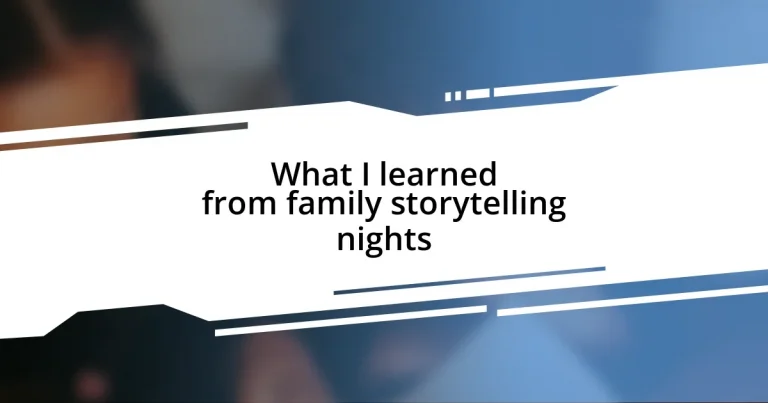Key takeaways:
- Family storytelling strengthens bonds and cultivates empathy, transforming casual conversations into meaningful connections.
- Effective storytelling techniques, such as imagery, dialogue, and pacing, enhance the emotional impact and engagement of shared narratives.
- Creating a consistent storytelling routine involves everyone and encourages participation, fostering a collaborative and inclusive atmosphere.
- Reflecting on shared stories deepens understanding of family history and encourages emotional connections through vulnerability and shared experiences.
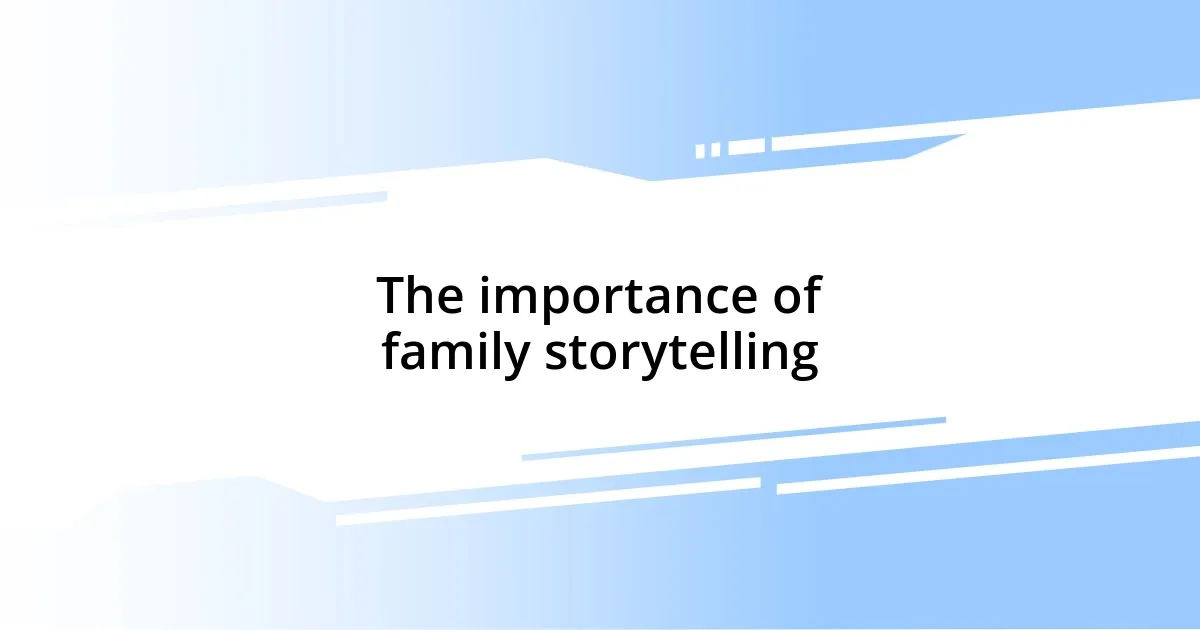
The importance of family storytelling
Family storytelling holds a special place in our hearts, acting as a bridge between generations. I remember sitting wide-eyed as my grandmother recounted tales from her childhood, filled with both humor and hardship. Those stories taught me lessons I didn’t even realize I was absorbing at the time; they shaped my understanding of resilience and compassion.
There’s something inherently comforting in hearing familiar voices share laughter and lessons from the past. It prompts me to think—how often do we pause to share our own stories? When I share my experiences with my family, I can feel the bond tighten, transforming casual conversations into meaningful connections. These narratives don’t just entertain; they cultivate empathy and understanding, allowing us to see the world through each other’s eyes.
Moreover, storytelling fosters a sense of identity. I often reflect on how hearing my father’s tales of his own struggles and triumphs influenced my own aspirations and fears. Isn’t it fascinating that these shared moments can help us navigate our individual journeys? In essence, storytelling isn’t just an act; it’s a way of imparting wisdom, building bonds, and crafting our family legacy.
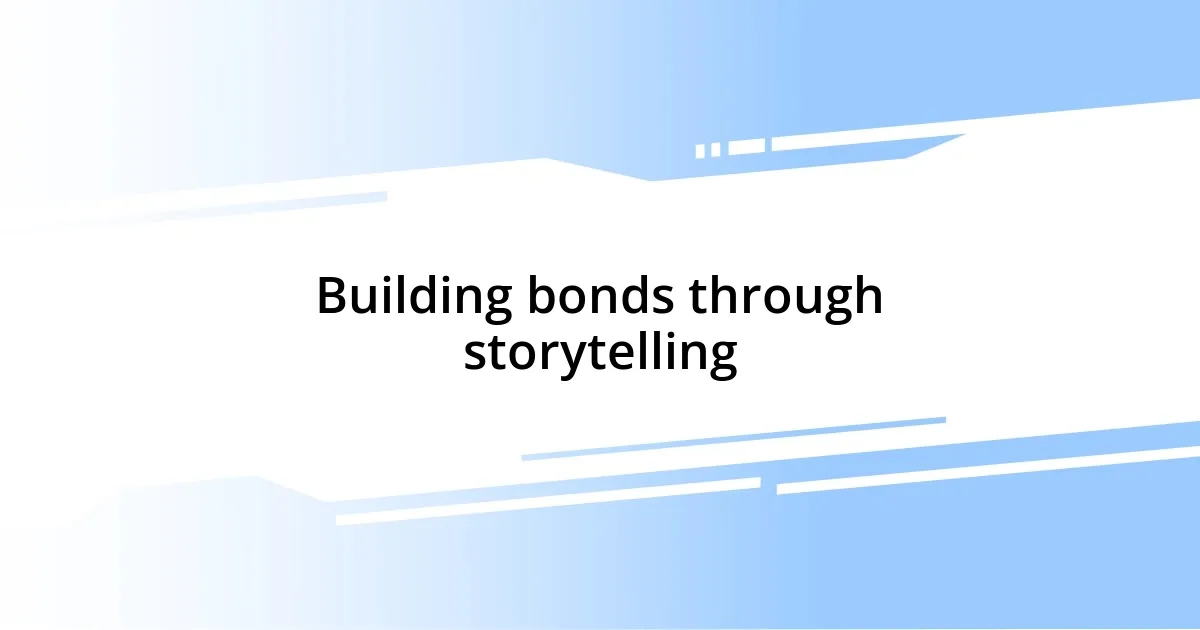
Building bonds through storytelling
The act of sharing stories feels like weaving threads into a family tapestry, each tale adding depth and color. I can still picture the glow of the firelight as my cousin recounted the time we got lost on a hiking trail. That shared laughter not only eased the anxiety we felt at the time but also solidified our bond, reminding us of the adventure and, more importantly, the support we offered one another. Storytelling creates threads of shared experiences that draw us closer, enabling us to revisit moments of joy, sorrow, and growth together.
- It fosters an environment of trust, as we reveal parts of ourselves through storytelling.
- Listening to someone’s story can spark empathy, allowing family members to connect on deeper emotional levels.
- Repeated storytelling of cherished family events strengthens shared memories and inside jokes, reinforcing our collective identity.
- Engaging in this practice can encourage younger generations to share their experiences, continuing the cycle of connection.

Techniques for effective storytelling
Mastering storytelling techniques can transform a simple tale into a captivating experience. One effective method is to utilize vivid imagery—painting a picture with words. I once told a story about our family vacation at the beach, describing the smell of salt in the air and the feel of warm sand beneath our toes. My audience was drawn in, as if they were right there with me, experiencing the fun and laughter. Imagery creates emotional connections, making stories memorable.
Incorporating dialogue is another powerful technique I’ve found useful. When I shared a family anecdote about a dinner gone hilariously wrong, using the actual words spoken by my relatives brought the tale to life. It felt almost like we were re-living that evening together. This approach not only adds authenticity but also engages listeners, allowing them to visualize the characters and their emotions. Ask yourself, have you ever shared a story that made someone feel like they were part of that moment? That’s the impact of engaging storytelling.
Additionally, pacing can greatly enhance storytelling. I learned this while recounting a suspenseful Christmas Eve when my siblings and I were convinced Santa was watching us. I deliberately slowed down at the climactic moment, heightening the tension. It left everyone on the edge of their seats. Effective pacing creates anticipation and keeps the audience hooked, turning a simple story into an unforgettable experience.
| Technique | Description |
|---|---|
| Imagery | Using vivid descriptions to create mental pictures that evoke emotions. |
| Dialogue | Including characters’ spoken words to add authenticity and engagement. |
| Pacing | Adjusting the speed of the narrative to create suspense and maintain interest. |
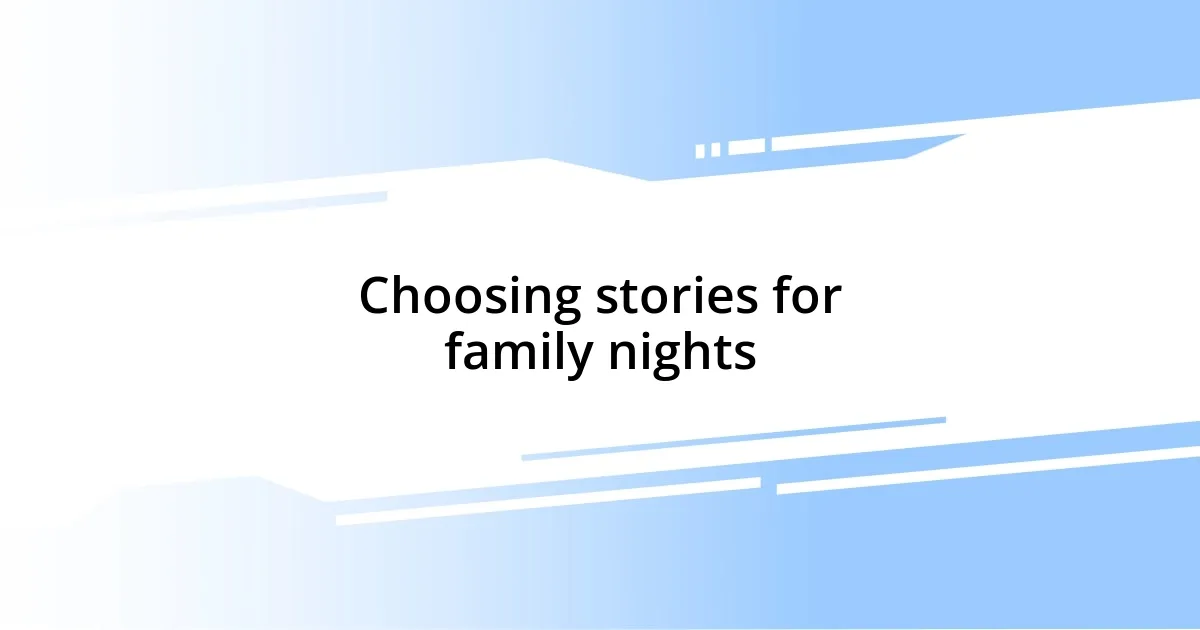
Choosing stories for family nights
Choosing the right stories for family storytelling nights can truly shape the experience. I remember one evening I shared a tale about my granddad and his mischievous dog. The laughter that erupted at the antics depicted in the story drew everyone in, creating a lighthearted atmosphere. It’s amazing how a well-chosen story can invite everyone to reminisce while also sparking joy and connection.
What I’ve learned is that it’s crucial to consider the audience when selecting a story. I once opted for a nostalgic tale from my childhood that I thought might resonate with my younger cousins. However, I quickly realized they were more engaged by the goofy moments when I included them in the storytelling. Their enthusiastic giggles reminded me how important it is to ensure that everyone feels represented and engaged. Have you noticed how certain stories can light up the room?
I also find that revisiting familiar family narratives works wonders to strengthen bonds. Sharing the same beloved stories over time makes them like old friends—always welcome and instantly relatable. One night, when I shared a well-loved account of our family campfire escapade, I was reminded of how those frequent retellings reinforce our shared identity. It’s a joy to see how storytelling fosters connection across generations, ensuring that our family legacy is preserved through laughter and love.

Creating a storytelling routine
Creating a storytelling routine is a delightful journey that evolves over time. I remember our first attempt felt a bit awkward, as we scrambled to find a rhythm, but incorporating storytelling as a weekly tradition quickly changed the atmosphere in our home. Each session became an eagerly anticipated event—like a little family reunion that brought everyone together, even if we were all sitting in our living room. Have you ever considered how simple routines can forge deeper connections?
Setting a specific day and time made it easier for everyone to participate consistently. I decided to initiate storytelling nights every Friday after dinner. As the weeks went by, what started as an experiment transformed into a cherished ritual. I looked forward to the laughter and conversation that flowed from the stories—each tale sparking new discussions and memories. Is there a better way to spend time with loved ones than sharing moments that make you laugh or even shed a tear?
To keep it fresh, we alternated the storyteller each week, allowing every family member’s voice to shine. I recall one evening when my youngest niece, with her exaggerated expressions and animated delivery, stole the show with her tale about a magical garden. It made me realize that involving everyone not only ensured variety but also nurtured confidence and creativity among us. How does opening up the storytelling stage to everyone at the table frame the stories we hear? It creates a beautiful tapestry woven from different perspectives, enriching our collective experience.
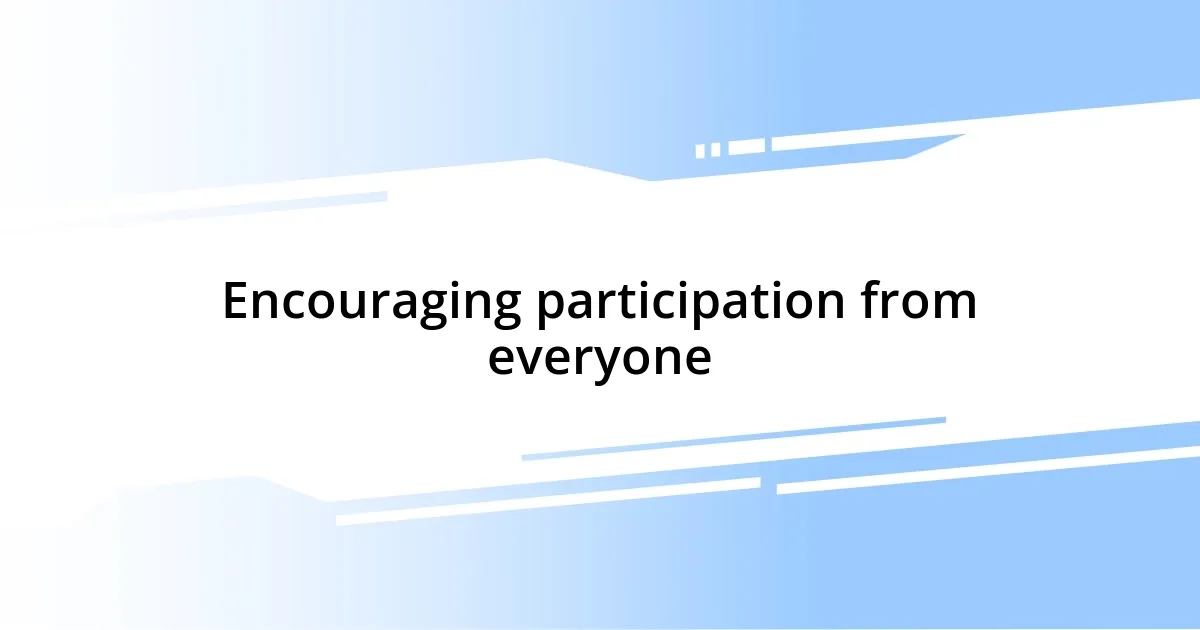
Encouraging participation from everyone
Encouraging participation from everyone can turn storytelling into a truly collaborative experience. I vividly remember a night when I invited my teenage nephew to share his favorite video game storyline. Watching him become animated as he narrated his thrilling adventures made me realize how powerful personal input can be. Isn’t it fascinating how breaking the mold and letting younger voices be heard can bring a fresh energy that resonates throughout the family?
Creating an inclusive atmosphere is essential. I often find that when I actively ask questions and draw out shy family members, it encourages them to dive in. For example, there was an evening when my quiet sister finally opened up, sharing her own childhood memories of a family summer trip. The way she lit up while recounting her excitement was a reminder of the hidden gems waiting to be discovered in every family member. Have you experienced that moment when someone surprises you with a story that reveals a different side of them?
Moreover, incorporating fun elements can spark engagement in unexpected ways. One night, I introduced a ‘story prompt’ jar filled with quirky themes and ideas for everyone to choose from. The look of surprise on my dad’s face when he pulled out “your most embarrassing moment” was priceless! It not only got everyone laughing but also laid the groundwork for deeper conversations and shared vulnerabilities. Isn’t it amazing how laughter and shared experiences can act as bridges connecting us? It really drives home the idea that storytelling is not just about relaying events; it’s about nurturing relationships.

Reflection and lessons learned
Reflecting on our storytelling nights, I genuinely appreciate how they transformed not just our weekends but also each family member’s connection to one another. One evening, as I listened intently to my cousin’s recollection of our grandparent’s arrival in America, it hit me how these stories breathe life into our family’s history. Isn’t it amazing how sharing such narratives allows us to understand our roots better?
I’ve also learned that the stories shared often dig deeper than mere entertainment—they serve as a mirror reflecting our values, struggles, and triumphs. I distinctly remember when my brother opened up about a challenging period in his life; the vulnerability he displayed fostered an unspoken bond among us all. How often do we have the opportunity to connect on such an emotional level in our busy lives?
In those moments, I realized that storytelling builds empathy. It gives each of us a glimpse into the experiences and emotions of others. I think back to a night when my aunt spoke candidly about her fears as a new parent. Her willingness to share allowed us to express compassion and support in ways we hadn’t before. Isn’t it reassuring to know that, even in our imperfections, we can find common ground that deepens our relationships?












